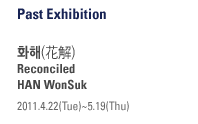
- GALLERY
- CURRENT
- UPCOMING
- PAST
- GALLERY
- CURRENT
- UPCOMING
- PAST
- Half side/Other side
- EIN STEIN Thinking about Thinking
- Fiminism Fnositicism
- Portrait the Nature:Stars and Flowers
- white-hole diary
- ART369
- ABSINTHE1
- Completion in Incompletion
- Full of Emptiness
- Luminizing Sequence 2: Into the Maze of Momentum
- Characterless Characters
- Architecture of Illusion
- Whispering of Layers
- Small is Beautiful
- Urban Park
- Construction & De-Construction
- Serious Joke
- Retrospective
- 위대한 설계
- Fearless Creation
- Some Watchtower
- Fantasy Factor
- 적극가담자-방관자
- Root of Imagination
- SIGMA COMPLEX
- K's Room
- SUM IN A POINT OF TIME
- Memories
- Ordinary People
- Root of Imagination
- 幻 Solid Illusion
- 화해: Reconciled
- ARTISTS
- CHA Seung Ean
- CHANG Cheol Won
- CHOI Won Jung
- CHOI Wool Ga
- HAN Jin Su
- HAN Won Suk
- HONG Buhm
- HONG Zi
- KIM Ha Young
- KIM Ji Eun
- KIM Ki Ra
- KIM Si Nae
- KIM Young Bae
- LEEFI
- LEE Seung Min
- LEE Su Jin
- LEE Yeon Sook
- LEE Yong Baek
- PAE Sung Hee
- PARK Cheon Wook
- PARK Jung Hyuk
- PARK Mun Hee
- PARK Sang Ho
- PARK Seung Mo
- PARK Seung Yea
- PARK Sung Yeon
- RYU Jung Min
- RYU SungHun
- SEO Min Jeong
- SIM Seung Wook
- YOON Byung Woon
- NEWS
- TOMORROW+







2003년 처음 만난 한원석은 경계성 성격장애, 대인기피증을 가진 사람이었다. 수틀리면 버럭 질러대는 고함소리는 귀에 거슬렸고, 안 되는 것도 될 수 있다는 고집은 고개를 절레절레 흔들게 만들었다. 그러다가도 혹 길에서 껌 파는 할머니라도 만나면 꼬옥 돈을 쥐어 준다. 그것도 천진한 얼굴을 하며 “할머니 오래오래 많이 파세요”. 좀 전까지만 해도 에스프레소 사먹을 돈이 없다 투덜대던 사람이 어디서 만 원짜리 선심이 나온 것인지. 비상금이라고 생각하고 지나치지만 그의 언어와 행동의 진폭은 보통사람의 그것보다 훨씬 크다. 그래서 당황스럽고, 그래서 이해하는데 한참이 걸렸다.
그에게 있어 사회가 만들어 놓은 해야 될 것과 해선 안 되는 것에 대한 경계선은 중요치 않아 보인다. 화가가 되고 싶어 노가다 판에 뛰어 들더니 진짜 건축가가 되었고, 음악이 좋아 소리를 쫓더니 꽤 괜찮은 소리작업도 만들어 냈다. 한 동안 베이징 798에선 대안공간도 운영했었고 거기서 페스티벌도 기획했었다. 자기가 하고 싶은 행동과 가고 싶은 길을 가는 게 중요하지 사람들의 시선 따윈 무시해도 좋다는 식이다. 괜히 고집 피우다 주변 사람들이 자기를 오해하고 부정적으로 바라볼 수 있다는 사실도 잘 알고 있다. 그러나 그렇게 쌓이게 될 오해 역시 신경 쓰지 않는다. 그래서 사람들에 대한 “실수”도 많았다. 필자 역시 비슷한 이유로 한동안 그를 멀리하고 보지 않았다.
2010년 가을 한원석 작가를 다시 만났다. 작품에 많은 변화가 있었다. 2003년 죄수복을 입고 담배꽁초 수십만 개를 쌓아 올린 “악의 꽃”으로 출발했을 때만해도, 다시는 버려진 오브제(사람들은 이를 “쓰레기”라고 부른다.)를 예술품으로 바꾸려는 무모한 시도는 하지 않을 것이라 생각했다. 막대한 시간과 노동을 투자해야 할 수 있는 전시였기 때문이다. 예상은 빗나갔다. 2006년 1374개의 버려진 자동차 헤드라이트를 모아 첨성대 작품 “환생”을 만들더니, 2년 뒤 2008년에는 3088개의 스피커를 모아 성덕대왕신종을 재현한 “형연”을 선보였다. 사회로부터 버려진 것들을 모아 예술작품으로 환생시키겠다는 최초의 약속을 지켜온 것이다.
말 그대로 “꽃을 풀어내다”란 뜻에서 출발한 전시 “화해”는 그 동안 표현하지 못했던 속마음을 털어 놓는 공간이다. 이를 위해 40여 일간 1만 6000여개의 스피커를 전시장 벽면에 붙혀 나갔다. 처음에는 큐레이터(필자)와의 작은 화해에서 시작되었지만, 이내 세상과의 화해, 환경과의 화해, 자연과의 화해, 그리고 작가 자신과의 화해로 확장되었다. 전시장을 가득 메우고 있는 1만 6000개의 검은색 스피커에 둘러 쌓인 소리의 방으로 걸어 들어가자 희미한 울림이 점점 커진다. 그러나 소리의 출처를 찾기 쉽지 않다. 벽면의 수많은 스피커들 중 어느 것 하나 소리를 내지 않기 때문이다. 어두운 전시장을 가득 메우고 있는 소리와 침묵하고 있는 스피커란 아이러니한 상황이 말을 건네고 싶지만 머뭇거리고 침묵하는 현대인들의 모습을 연상시킨다.
첨성대, 성덕대왕 신종 등 이전까지 한국의 문화적 뿌리를 상징하는 형상을 만들었다면, 이번에는 형상 자체를 지워 버렸다. 그래서 소리에 좀 더 몰입 할 수 있도록 했다. 대신 인공적 소리의 원리와 자연의 소리의 원리 사이에서 접점을 발견하는데 집중했다. 원리는 비교적 간단했다. 일반적으로 스피커가 특정 방향으로 소리를 전하는 지향성이라면, 그가 만들어 내는 옻칠된 지관 스피커는 인간의 목소리처럼 소리가 사방으로 퍼진다. 무지향성이다. 1만 6000개의 스피커 중 달랑 1개를 떼어와 전시장 중앙에 위치한 둥그런 지관 울림통에 설치했을 뿐인데 효과는 일당 백이다. 작은 스피커 하나로 큰 반향을 일으킨 것이다.
쓰레기와 예술, 인간과 자연, 문명과 환경, 전면과 후면, 빛과 그림자 등 한원석 작품의 큰 특징은 이원론적 구조 사이의 경계 위에 있다. 그리고 이를 건축가답게 매우 구체적으로 보여준다. 그림이 그려진 전면만 강조하는 회화에 반기를 들고, 냄새 나는 담배꽁초 작업으로 전면과 이면이 공존할 수 있다는 사실을 보여주었고(작가에게 있어 냄새 나는 이면이 진실이고 화려한 꽃이 그려진 전면이 허상이다), 폐 헤드라이트에서 뿜어져 나오는 LED 빛을 통해 첨성대의 역사적, 공간적 한계상황을 극복하며 미래의 빛을 만들어 냈고, 폐 스피커 작업을 통해 가시적인 영역과 비가시적인 영역 사이에 다리를 놓았다.
이렇듯 냄새, 빛, 소리 등을 고집스럽게 수집해온 한원석의 일관된 주제는 욕망이다. 그는 그것을 개인의 욕망과 사회적 욕망으로 나눈다. 가족에 대한 사랑, 나 자신에 대한 사랑을 개인의 욕망으로, 사회적 욕망은 출세욕, 권력욕, 물욕 등으로 요약한다. 그리고 점차 괴물처럼 거대해지고 있는 사회적 욕망과 점차 사라져 가는 개인의 욕망 사이의 불균형을 회복할 처방제를 “쓰레기” 더미에서 찾는다. 인간의 쾌락과 사회적 편의를 위한 욕망에 의해 태어났지만, 그 기능을 다하고 버려져야만 하는 “쓰레기”야 말로 최적의 소재가 아닐 수 없다. 냄새, 빛, 소리 모두 생명의 상징이기에 버려진 오브제가 쉽게 탈맥락화하되어 새로운 의미와 생명력을 발휘하게 되는 것이다. “쓰레기를 작품으로” 바꿀 수 있다는 그의 믿음이 만들어 낸 편집증적인 수집보다 놀라운 것은 그가 기꺼이 스스로를 “죄인”, “회개자”로 명명하며 죄수복을 입고 작업한다는 사실이다. 그것이 일시적이면 퍼포먼스라고 말할 텐데, 벌써 10년째다. 언어로 진심을 표현할 줄 모르는 이 괴팍한 아티스트가 세상과 화해하는 방법 역시 꽤나 유별나다. 그래서 힘들 사람들보다 그래서 바뀔 세상에 대한 가치가 더 크다고 믿는 한원석이다.
이대형 (대표/Hzone)
![]()
The Han WonSuk I met in 2003 was a person with a borderline personality disorder. His abrupt tantrums-when things didn’t go as planned - were more than unpleasant and his stubborn black and white thinking on “Nothing is impossible!” made me shake my head. At the same time, when he met an elderly woman on the street selling chewing gum, he would never pass by without giving money.
He - who just a moment ago was complaining that he didn’t have money for an espresso - suddenly showed 10,000 won worth of kindness. In this way, the amplitude of his language and behavior is much greater than that of most people. It took me many years to understand him.
The boundary of dos and don’ts imposed by society does not seem to be important to Han the artist. With the hope of becoming an artist, he put himself on a construction site then he really became an architect; with a love for music he pursued sound and created a pretty good sound work. For a while Han ran an alternative space at Beijing 798 Art District and planned cultural and artistic festivals. He believes it’s important to act and follow the road he chooses and not be too concerned with other people’s opinions. Although he knows well that his stubbornness can bring forward misunderstandings, that too is no big deal to Han. Therefore, there have been many unintended “mistakes” with people. I was one of many who had shunned him for years.
In the fall of 2010, I met the artist again. There had been abundant changes in his work. When he presented “The Flower of Evil” in 2003, where he accumulated few hundred thousand cigarette butts, I thought he would never again attempt to transform abandoned objects (people call them “trash”) into a work of art, as it was an exhibition that required an extreme time commitment and devoted labor. I was wrong. In 2006, Han collected 1374 headlights of disowned cars in creating his Cheomseongdae piece - “Rebirth” - and two years later in 2008, he compiled 3088 speakers in reproducing the Great King of Sung Duk’s Bell in “Hyeong Yeon”. He kept his initial promise of resurrecting abandoned things from society into works of art.
This exhibition, “Reconciled”, which departs from the literal meaning of “unraveling the flower”, embraces a space to communicate the feelings the artist was not able to express until now. For 40 days, 16,000 speakers were attached to all sides of the exhibition space. It began with a reconciliation with the curator - myself - but shortly it expanded into a reconciliation with the world, the environment, nature and lastly the artist himself. Walking into the exhibition space packed with 16,000 black speakers, a faint echo gradually grows. However it is not easy to find the origin of the sound. The viewers encounter an overwhelming number of speakers but never imagines that all are silent except for one speaker. This ironic tug-of-war situation of a single speaker and 15,999 soundless speakers remind us of people in today’s society - wanting to approach yet silent.
If Han had made forms representing the cultural roots of Korea until now, such as Cheomseongdae and the Great King of Sung Duk’s Bell, this time he removes the form itself, allowing the audiences to focus on the sound. The artist focused on discovering the point of contact between the principles of the artificial and natural sound. The principle is rather simple. If ordinary speakers are direction-orientated - exporting sound in a particular direction - the pipe speakers painted with lacquer made by the artist transmits sounds in every direction; they are nondirectional. From the 16,000 speakers only one is removed and placed in the round sound pipe but the effect is phenomenal - Han’s small speaker has just reached the quality of the natural sound.
The most notable characteristic in Han’s work lies between the boundary of dual structures such as; trash and art, human and nature, civilization and environment, front and back, light and shadow. He demonstrates these in a very specific way like an architect. The artist has rebelled against painting, which only focuses on the facade and through his working with cigarette butts, Han demonstrates that front and back can coexist. (To the artist, the smelly side is truth and the facade with the attractive flower is illusion.)
Through the use of LED lights from abandoned headlights, he surpasses the historical and spacial context of Cheomseongdae and redirects the light to the future. And lastly through the discarded speaker work, Han creates a bridge between visible and non-visible territories.
Han’s persistent collection of abandoned objects of smell, light, and sound leads to a coherent subject - desire - which he divides into individual desire and social desire. He defines love towards family and oneself as individual desire, while ambition for success, longing for authority and worldly pleasure as social desire. From the pile of “trash,” the artist hopes for a cure that will restore the imbalance of diminishing individual desire and epidemically spawning social desire. “Trash” is the symbolic demise of the utility of convenience, desire, and pleasure of human civilization. It seamlessly fits into the theme. Therefore, his collage of trash is easily de-contextualized to build new meanings. What is more astonishing than Han’s obsession with the belief that “trash can be an art work” is his derogative positioning of himself as a criminal. So he works wearing an embarrassingly dirty prisoner’s uniform. If this penitent action was temporary, you can call it a “well-planned performance.” But the artist has been continuing this crazy performance for over 10 years. His crabby language often fails to deliver what he really means, but his action speaks loudly: “the value of the changing world is always bigger than the misunderstanding of people.”
LEE DaeHyung (Director, Hzone / President, Absinthe media bar)
